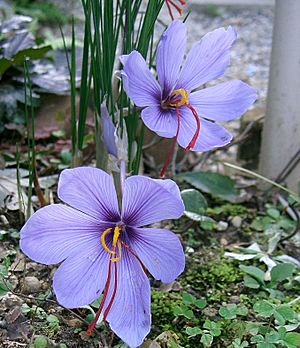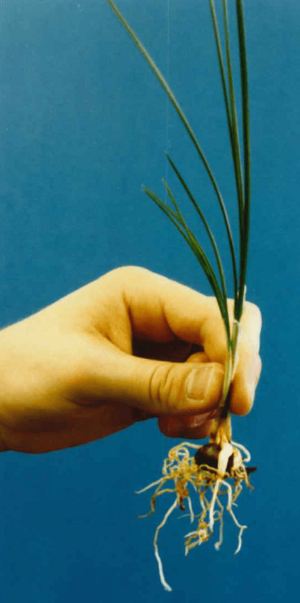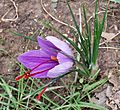Saffron crocus facts for kids
Quick facts for kids Saffron crocus |
|
|---|---|
 |
|
| Flowers showing crimson stigmas | |
| Scientific classification | |
| Genus: |
Crocus
|
| Species: |
sativus
|
| Synonyms | |
|
|
Crocus sativus, commonly known as saffron crocus, or autumn crocus, is a species of flowering plant of the Crocus genus in the iris family Iridaceae. It is best known for producing the spice saffron from the filaments that grow inside the flower. The term "autumn crocus" is also used for species in the Colchicum genus, which strongly resemble crocuses. However, crocuses have three stamens and three styles, while colchicums have six stamens and one style, and belong to a different family, Colchicaceae. Colchicums are also toxic.
This cormous autumn-flowering perennial plant species is unknown in the wild. Human cultivation of saffron crocus and use of saffron have taken place for more than 3,500 years and spans different cultures, continents, and civilizations (see History of saffron). Crocus sativus is currently known to grow in the Mediterranean, East Asia, and Irano-Turanian Region. Saffron is the triploid form of a species found in Eastern Greece, Crocus cartwrightianus; it probably appeared first in Southern Greece on the Attic peninsula or the island of Crete. An origin in Western or Central Asia, although often suspected, is not supported by botanical research. Other sources suggested some genetic input from Crocus pallasii, which has not been verified by chromosome and genome comparisons.
Contents
Morphology
Crocus sativus has a corm, which holds leaves, bracts, bracteole, and the flowering stalk. These are protected by the corm underground. C. sativus generally blooms with purple flowers in the autumn. The plant grows about 10 to 30 cm high. C. sativus is a triploid with 24 chromosomes (2n = 3x = 24), which means it has three times the haploid number of chromosomes. This makes the plant sterile due to its inability to pair chromosomes during meiosis.
Cultivation
Crocus sativus is unknown in the wild, and its ancestor is unknown. The species Crocus cartwrightianus is the most probable ancestor, but C. thomassi and C. pallasii are still being considered as potential predecessors. Manual vegetative multiplication is necessary to produce offspring for this species as the plant itself is a triploid that is self-incompatible and male sterile, therefore rendering it incapable of sexual reproduction. This inability to reproduce on its own supports the hypothesis that C. sativus is a mutant descending from C. carthwrightianus as a result of selective breeding.
Corms of Crocus sativus should be planted 10 cm (4 in) apart and in a trough 10 cm (4 in) deep. The flower grows best in areas of full sun in well-drained soil with moderate levels of organic content. The corms will multiply after each year, and will last 3–5 years.
Use
Saffron is considered to be the most valuable spice by weight. Depending on the size of harvested stigmas, 50,000–75,000 Crocus sativus plants are needed to produce about 1 pound of saffron; each flower only produces three stigmas. Stigmas should be harvested mid-morning when the flowers are fully opened. The saffron crocus (Crocus sativus) should not be confused with "meadow" saffron or autumn crocus (Colchicum autumnale) which is poisonous.
Breeding
As C. sativus is infertile, all cultured individuals of this plant are clonal. There is minimal genetic diversity from the single domestication event, making it quite hard to find ones with new, potentially beneficial properties, let alone combine them by breeding. Cultivars of saffron are nevertheless produced by:
- Clonal selection. Any plant with a desirable mutation is kept and further grown. This is the traditional approach.
- Mutation breeding. Mutagenesis can be used to cause a wide range of mutations to select from. The traditional clonal process follows.
- Sexual reproduction. Breeding for desirable features is much easier in fertile plants.
- Although the plant is not self-fertile, some wild relatives can be successfully cross-pollinated with saffron pollen in vitro and form seeds. This would create a fertile diploid plant with the features of C. sativus to work from.
- A chromosome doubling would also create a fertile plant, albeit a hexaploid. Such a change may be possible via colchicine.
Gallery
-
Flower's profile, Serra de Casteltallat, Catalonia, Spain
-
Pollen, Afghanistan
See also
 In Spanish: Crocus sativus para niños
In Spanish: Crocus sativus para niños







